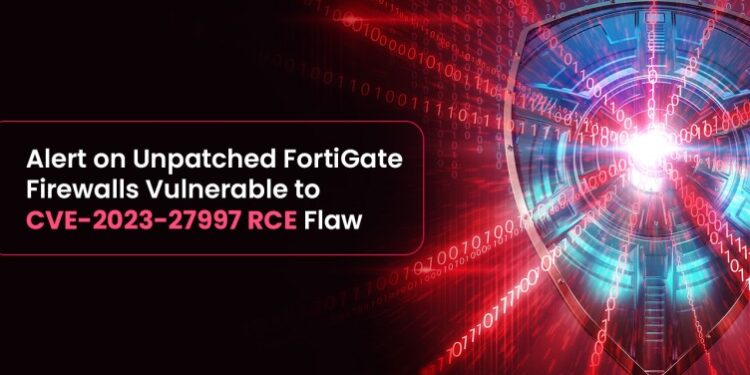Unpatched FortiGate Firewalls: A Looming Security Threat
Introduction
In today’s interconnected world, cybersecurity is of paramount importance. Organizations rely on robust firewalls to protect their networks from potential threats. However, a critical security flaw has recently been discovered in Fortinet FortiOS and FortiProxy SSL-VPN appliances, putting unpatched FortiGate firewalls at risk. In this article, we will explore the implications of this vulnerability, the extent of its exploitation, and the urgent need for users to update their devices promptly.
The Vulnerability: CVE-2023-27997 (XORtigate)
The vulnerability, known as CVE-2023-27997 or XORtigate, is a remote code execution (RCE) flaw with a CVSS score of 9.8. This heap-based vulnerability allows remote attackers to execute arbitrary code or commands through specifically crafted requests. The severity of this vulnerability cannot be overstated, as it puts sensitive data, critical infrastructure, and government systems at risk.
The Magnitude of the Issue
Recent reports indicate that a staggering 330,000 FortiGate firewalls remain unpatched, leaving them vulnerable to exploitation. Cybersecurity firm Bishop Fox conducted an analysis, revealing that approximately 69% of nearly 490,000 exposed Fortinet SSL-VPN interfaces on the internet have not been patched. This statistic highlights the urgent need for users to take immediate action to protect their systems and networks.
Exploitation in the Wild
The severity of the CVE-2023-27997 vulnerability becomes even more concerning when considering its active exploitation in the wild. Attackers have been quick to target vulnerable FortiGate firewalls, particularly in government, manufacturing, and critical infrastructure sectors. Fortinet acknowledges that the flaw may have been exploited in a limited number of cases already. This underscores the urgency for users to update their devices to the latest patched version promptly.
Fortinet’s Response and Patch Release
Fortinet, the vendor behind FortiGate firewalls, has taken swift action to address the vulnerability. The company released patches last month in versions 6.0.17, 6.2.15, 6.4.13, 7.0.12, and 7.2.5 of the FortiOS firmware. These patches aim to mitigate the risks associated with the CVE-2023-27997 vulnerability and protect users’ systems from potential attacks.
Lack of Patching: A Cause for Concern
One troubling discovery made during Bishop Fox’s analysis is that many publicly accessible Fortinet devices have not received updates for the past eight years. These installations are still running outdated FortiOS versions 5 and 6, leaving them highly vulnerable to exploitation. This lack of patching highlights the need for users to prioritize regular updates and security maintenance to protect their networks effectively.
Recommended Actions for Users
To safeguard against potential attacks and mitigate the risks associated with the CVE-2023-27997 vulnerability, users must take action immediately. Here are some recommended steps to protect your FortiGate firewalls:
1. Apply the Available Patches
First and foremost, it is crucial to apply the available patches provided by Fortinet. Ensure that you update your FortiGate firewalls to versions 6.0.17, 6.2.15, 6.4.13, 7.0.12, or 7.2.5. These patches contain essential security updates that address the CVE-2023-27997 vulnerability and strengthen the overall security of your devices.
2. Stay Informed with Security Advisories
Regularly check for firmware updates and security advisories provided by Fortinet. Staying informed about the latest patches and vulnerabilities is vital to maintaining a secure network environment. Fortinet frequently releases security advisories, which provide valuable information on emerging threats and necessary updates.
3. Implement Additional Security Measures
Consider implementing additional security measures to enhance your overall cybersecurity posture. Network segmentation, access controls, and monitoring can provide additional layers of protection against potential attacks. These measures can help detect and mitigate threats before they can exploit vulnerabilities in your network.
Conclusion
The unpatched FortiGate firewalls vulnerable to the CVE-2023-27997 vulnerability pose a significant security risk. With active exploitation in the wild and a high number of devices remaining unpatched, the urgency to update these firewalls cannot be overstated. Fortinet has provided patches to address the vulnerability, and users must take immediate action to apply these updates. By staying proactive and prioritizing cybersecurity measures, organizations can protect their networks from potential attacks and safeguard their valuable data and resources.
Remember, the security of your network is in your hands. Take action now to secure your FortiGate firewalls and stay one step ahead of cyber threats.
Additional Information:
Primary Keyword: Unpatched FortiGate firewalls Secondary Keywords: CVE-2023-27997, XORtigate, remote code execution, vulnerability, Fortinet FortiOS, FortiProxy SSL-VPN appliances, Bishop Fox, exploit, patch, network security, cybersecurity, critical flaw, security measures, network segmentation, access controls.



